Learn the tips and tricks for painting a bathroom vanity that will last! This inexpensive yet professional-looking project saved our builder-grade vanity with a fresh coat of paint!
Painting this oak bathroom cabinet has been on our to-do list for years! We are so close to finishing up this bathroom renovation, that I almost can’t stand it!
So this is what we started with:
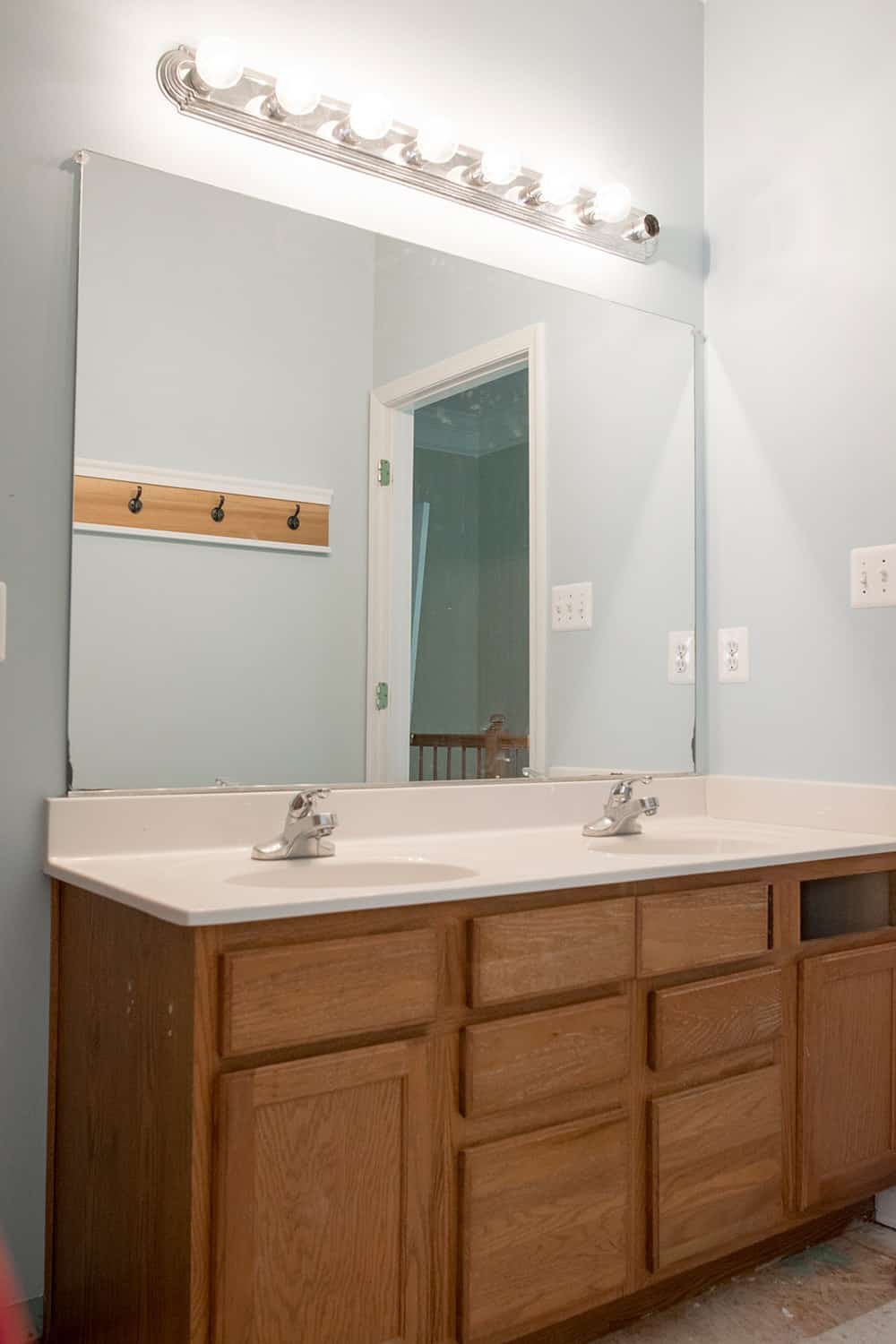
It’s not in great shape and the missing front piece has never been there since we moved in.
The awesome power of paint in a makeover never ceases to amaze and, frankly, I love that it is a huge budget saver. I have painted several furniture pieces over the years and am ready to tackle a little different job.
With only a quart of paint, the right tools, and a little knowledge, I made this into to a more modern guest bathroom!
Looking for some paint color inspiration for your project? I have scoured the internet to find specific examples and real-life paint examples in our post on Colorful Furniture Makeovers, 20 Sage Green Cabinet Paints, and the Best Blue Cabinet Paint Colors.
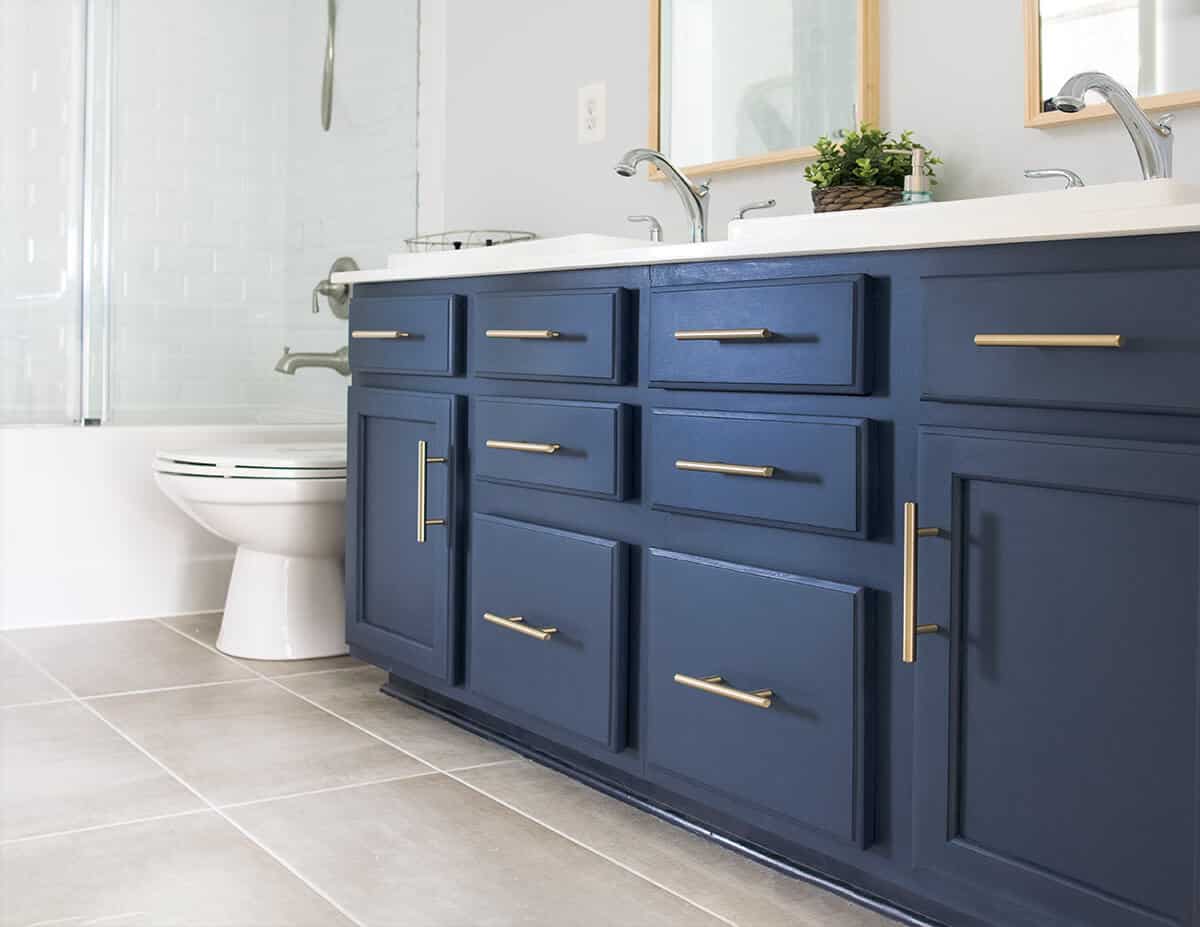
While it might seem like an intimidating project, with the right tools and some good advice, it’s perfect for a beginner DIY project. If this is a project you’ve considered tackling, this post will give you the step by step how-to to get it done! Let’s go…
Best Paint for Refinishing Bathroom Cabinet Doors
My best suggestion for a high-quality paint to use for painting your bathroom cabinets would be to use an enamel or acrylic type of paint. Do not use wall or latex paint to paint furniture!
I prefer Fusion Mineral Paint (which is an acrylic emulsion-based paint) for it’s waterproof matte finish that is HIGHLY durable. That is what I used for this bathroom makeover. I also really liked the color.
You Can Buy Fusion Mineral Paint Here.
I have tested many paints over the years, though, and have collected a giant list of the best paints for furniture to help you find the right one for your project!
Recommended Paint Project Supplies
- TSP Cleaner – A good quality degreasing cleaner should be fine too.
- Orbital Palm sander or mouse sander – 120 and 220 (or higher) grits
- Sanding blocks – this is for any areas that need hand sanding like details, edges, or inside corners.
- Painter’s Tape
- Stain-Blocker or Shellac Based Primer. These are only needed for very light or white colors. With Fusion mineral, I don’t need to prime a project unless it’s a tricky surface like laminate furniture.
- Paint Brush – my favorite for a smooth finish is 1.5-inch taklon brushes you can buy at craft stores. I have also used Wooster Angled Brushes and Purdy, which are good quality.
- Microfiber rollers
- Paint – (my favorites) Benjamin Moore Advance, Cabinet Transformations, Fusion Mineral, Rust-Oleum Chalked Ultra Matte
- Protective Topcoat – Here is my list of favorite protective topcoats. (optional- more on that later)
Pro Tip: If you use sanding sponges, I recommend getting a slightly lower (more coarse) grit than you would normally use in sandpaper. For example, instead of 220, I would use 180 grit or 80-100 to replace 120. The sanding sponge has a softer backing and seems to need a little more grabbing power than hard back sandpaper to provide the same smoothness. Also, save your sandpaper with these sandpaper cleaners!
Before Starting
The first step when painting a bathroom vanity is to remove the drawers, doors, and any cabinet hardware present so that only the frame is left.
If you are changing out the hardware to a different size, fill any holes in the old hardware.
Next, clean the frames and all doors and drawer fronts with either teaspoon or a household cleaner if the cabinet isn’t too nasty. I try to limit how much chemicals and teaspoon I use these days as it is quite strong and leaves a filmy residue that can be tricky to fully remove.
How To Prep Furniture for Painting
After cleaning, lightly sand the surface. The best bond requires some sanding, so I do not recommend skipping the sanding step. You want your paint to have the best bond for long-lasting results and a perfect finish.
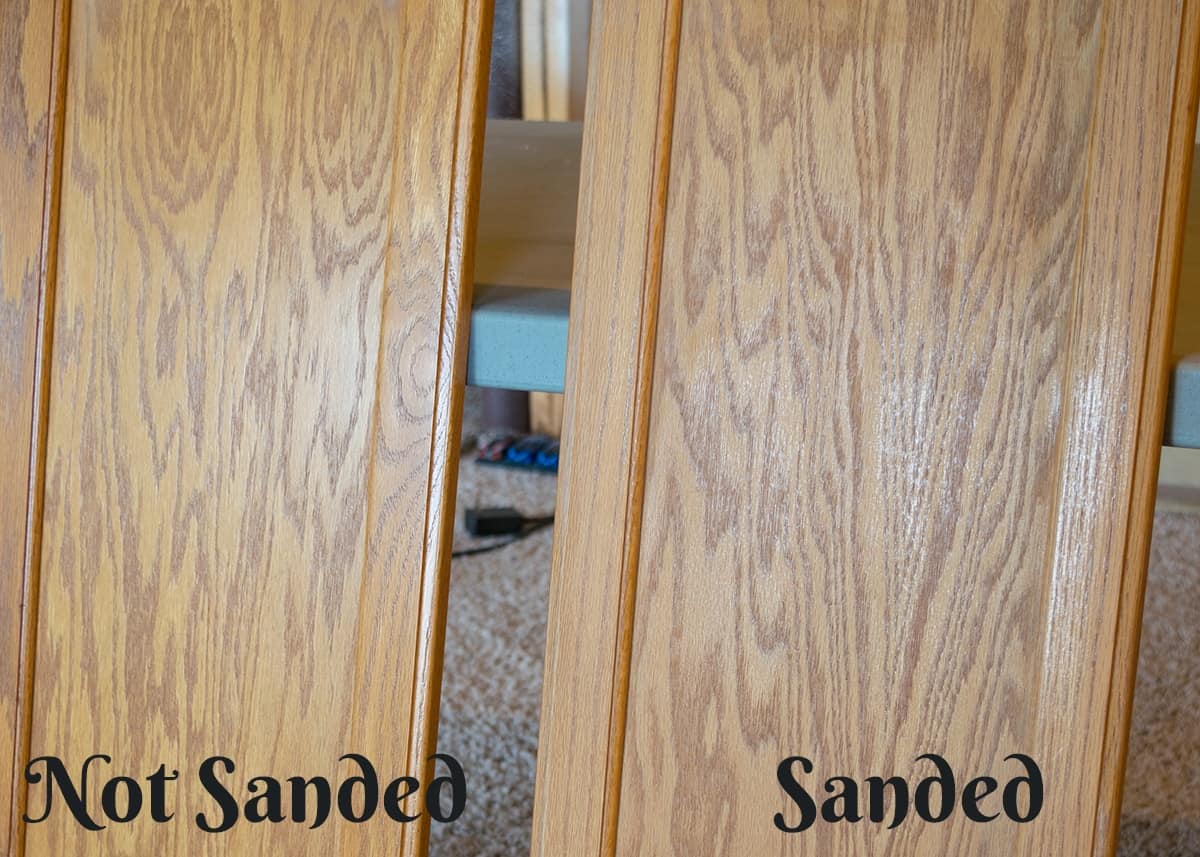
For sanding, you only need to “rough up” the surface. Unless the finish is peeling or breaking down, you do not need to completely remove all previous stain and varnish. I use an orbital sander with 80-120 grit and leave it at that. A 220 can be used for hand sanding any corners.
If you want to get a completely smooth finish on your cabinets and drawer fronts, we have a tutorial for filling in woodgrain on furniture. For dark colors with a matte sheen, I generally don’t find oak texture to be bothersome.
After everything is sanded, vacuum off the dust and wipe all of the surfaces down with a clean microfiber cloth or lint-free rag.
Tips for Painting a Vanity
Yes, the fun part! Here are some tips for the smoothest finish on your cabinets during your bathroom makeover:
- Get the right tools. A few extra dollars will save you a lot of heartache and frustration. I prefer fine taklon brushes like you find at craft stores for the least amount of brush strokes, but Purdy Brushes are also good especially if you have a self-leveling paint.
- Number the doors before you paint them. It just makes things a little easier, particularly if you have a lot of drawers that are the same size. The photo below is from a kitchen I painted.
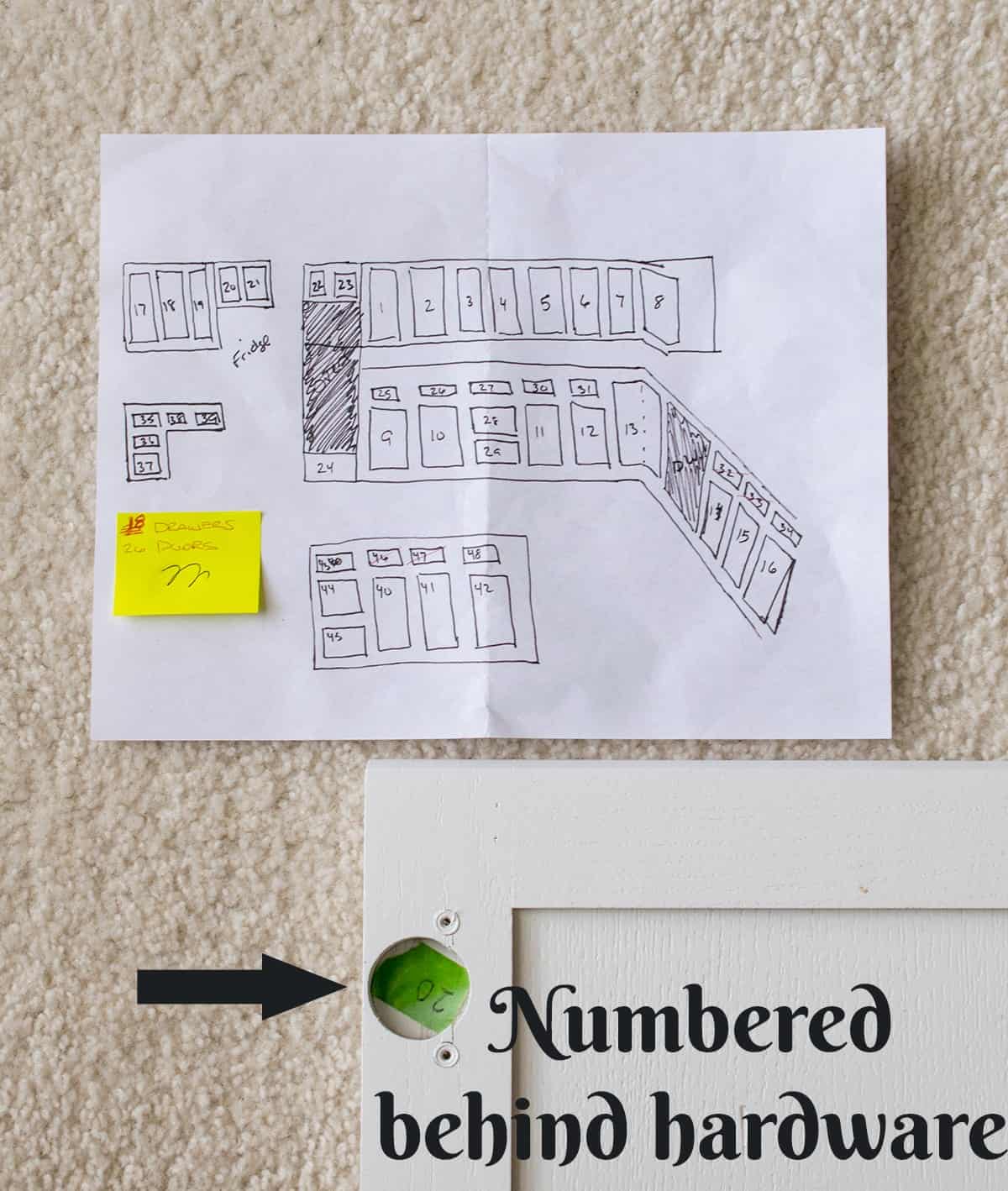
- Use an orbital sander with 100-120 grit sandpaper for the fastest, no marks removal of finish. You can sand with 220 just before the last coat if you like.
- Use a lint-free roller across all flat surfaces for the smoothest finish. Most paints prefer a low nap microfiber roller, but a few work well with foam rollers.
- Brush/rolling works better with matte paints than high sheen. A paint sprayer will consistently produce no brush marks though.
- Brush detail areas, then roll large flat surfaces before the paint has time to dry. You will get the best results, and this will eliminate brush strokes for a smooth paint finish.
- Paint in the direction of the grain. Painting across grain will look sloppy and show more brush strokes.
- Use a sandpaper cleaner block. Sandpaper is shockingly expensive, and you can usually make the sandpaper last twice as long with these cleaning blocks.
- Save rollers overnight. If you can’t finish a project all the coats in one day, it’s perfectly fine to wrap your rollers tightly in plastic wrap between coats for a day or two.
More furniture transformations!
- How to Eliminate Brush Marks or Strokes
- How to Paint Laminate Furniture
- How to Paint Old Kitchen Cabinets
- How to Paint a Stair Rail that Lasts
- The Best Sage Green Cabinet Paint Colors
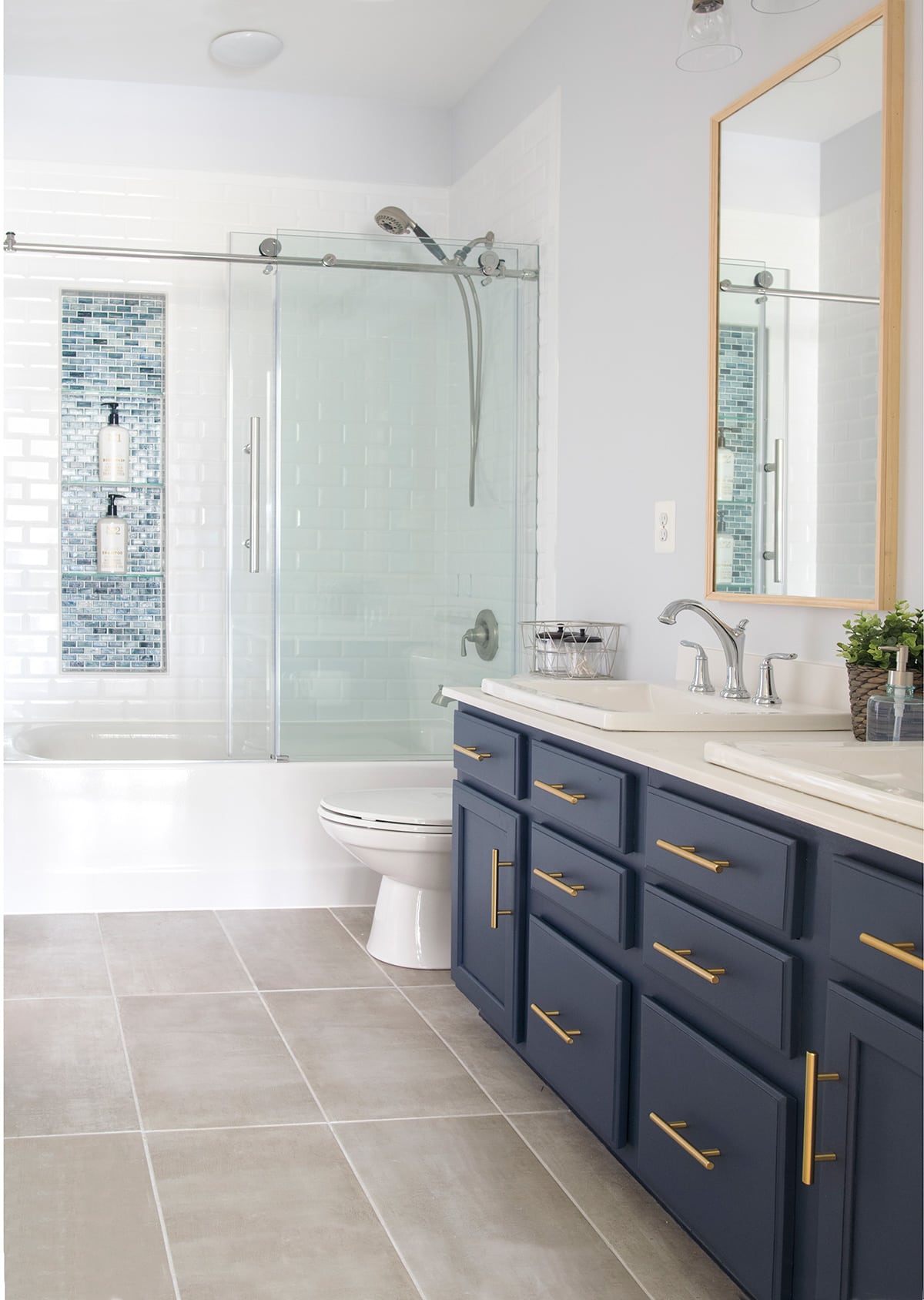
With a brush and microfiber roller, I painted 2 coats of paint. And that’s it!
Because I wanted to add hardware to this vanity, I drilled holes in each piece and screwed them in just like any other hardware.
See our full bathroom remodel reveal here.
Frequently Asked Questions
Yes! If you do not have any of the below problems, I would skip priming:
1. You are using an enamel paint that doesn’t require priming.
2. There is no risk of stains, tannins, oils, or grease coming through the paint. You do need to prime unfinished wood and knots every time.
3. You aren’t painting bright white (I like to use a stain-blocking coat of primer for white).
The color is Midnight Blue from Fusion Mineral Paints. The above pictures are the best reference for what the true color looks like in LOTS of natural light. However, it does appear darker at night or in shadow (it looks almost black). If you like navy blue, check out our post on the best Navy and Blue Cabinet Paint Colors.
I usually don’t paint the inside of the cabinets because it just isn’t worth the effort for me and is prone to scratching from heavy objects. Instead, I have used high quality contact paper or sealed the insides with a very durable clear coat to protect these areas.
Moisture is definitely going to be a factor when deciding what paint to use. As a result, I would use an enamel or acrylic type of paint. Fusion Mineral Paint is an Acrylic emulsion-based paint rather than something like chalk or latex which I would never use in a bathroom.
You can read more about the best paints for furniture here which shows my personal recommendations developed over years of refinishing and living with painted furniture.
No. The biggest misconception I see in painting is the idea that you need to sand between coats. Sanding is required only if your paint is not smooth to your liking and you are looking for a smoother surface. Paint bonds to paint without a problem.
With the paints I use, a topcoat is not usually required except in high traffic areas like kitchen cabinets. If you do choose to add a protective topcoat, read my recommendations on the best topcoats for furniture to help make a decision. Just make sure that it is water-based.
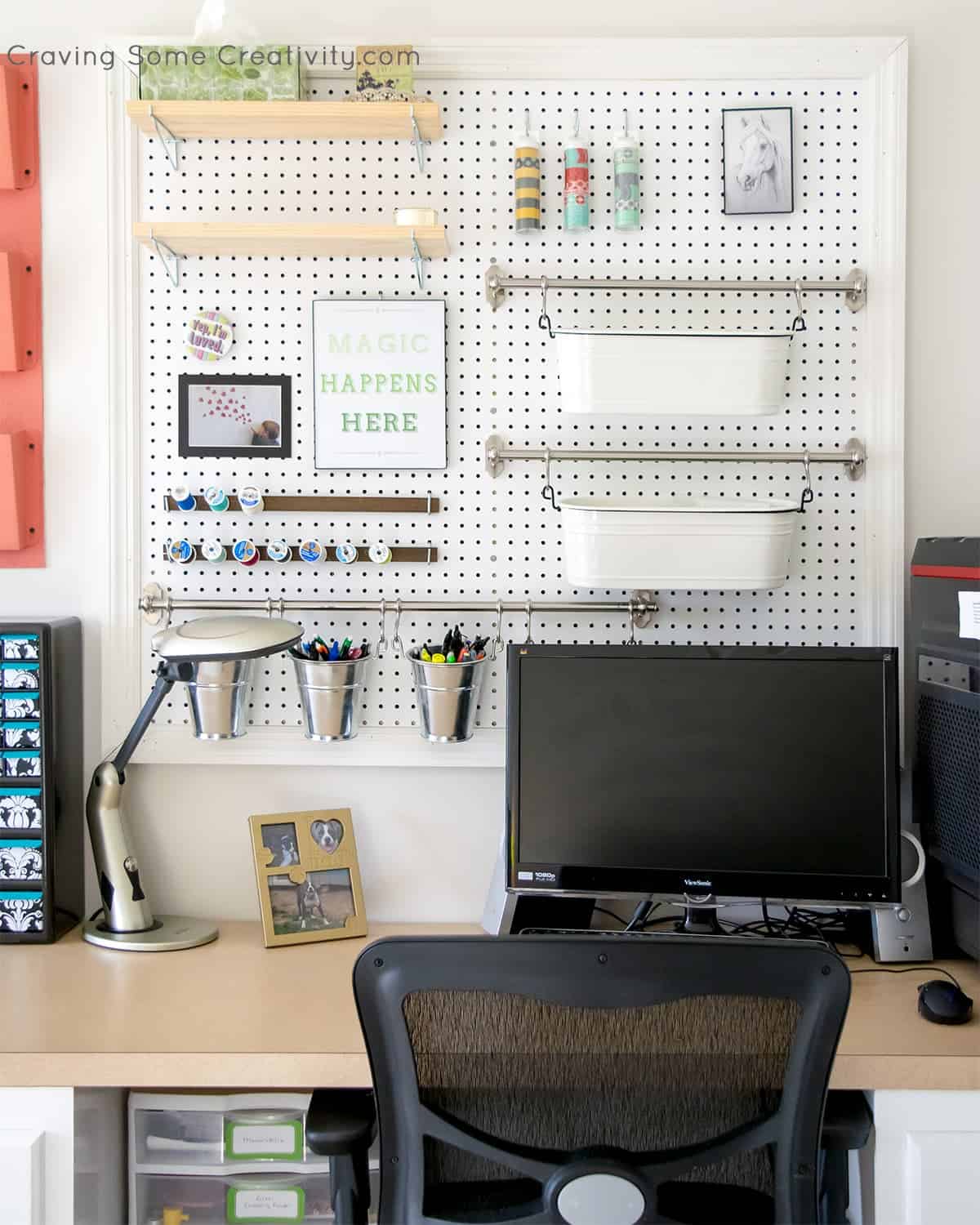
Grab our free series "Weekend Home Projects that will Transform Your Life" Sign up below to receive updates including free printables, organization tips, home improvement projects, recipes and more! |
More Furniture Painting Tutorials
PS I love seeing your creations! Be sure to take a photo and tag #cravingcreative on Instagram! You can also stay in touch with me through following me on Instagram, Pinterest, and subscribing to the newsletter!
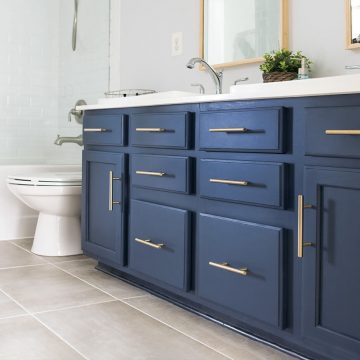
How To Paint a Bathroom Cabinet
Tools
- Orbital Sander with 120 and maybe 220 grit sandpaper
- Mouse Sander optional – better for corners
- Sanding Blocks
- Paint Tray
- Roller Frame
Supplies
- Degreasing Cleaner or TSP
- Sanding sponges 80-100 grit
- Paint's Tape
- Paint brushes see post for recommendations.
- Lint-free microfiber rollers
- Paint See my favorites to use in Notes
- Protective Top Coat Optional, but recommended.
- Stir sticks
- Something to prop up the doors/drawers for drying I use solo cups.
Instructions
- Prep the Vanity. Remove the hardware as well as the doors and drawers. Clean all surfaces using a degreasing cleaner. If you need something stronger, you can use TSP for getting grime and dirt off. Repair scratches with wood filler as necessary.
- Sand the surface. Sand enough to remove any sheen or gloss. An orbital sander with 100-120 grit makes the sanding much easier. 120 grit can be used for hand sanding any corners.
- Prepare your paint space. Tape off any edges you don't want painted such as under countertops or walls. For doors and drawer fronts, I allow them to dry on top of solo cups so they don't touch anything. If I left the drawers fronts on the drawers, it is fine to carefully put them in the vanity in open position to dry.
- Paint. See my notes below to decide if you need to prime first. Because these are small projects, we brush the details and then roll the large flat surfaces. Brush with the grain and always from one end to the other. If paint starts to dry, don't go back over it. Finish them off with a roller brush before the paint has time to dry for the smoothest finish.
Notes
- Painting over dark cabinets with a light or white color
- Oak Cabinets that have bad stains stains like deeply embedded oil or markers.
- Cabinets with knots in the wood such as knotty pine.
- Raw or unfinished wood.


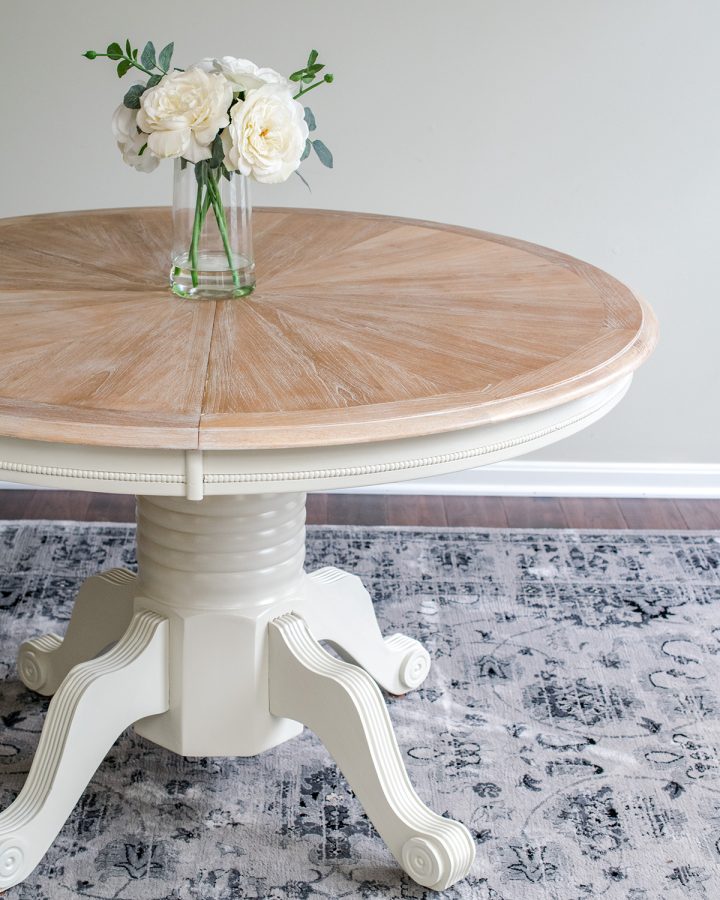
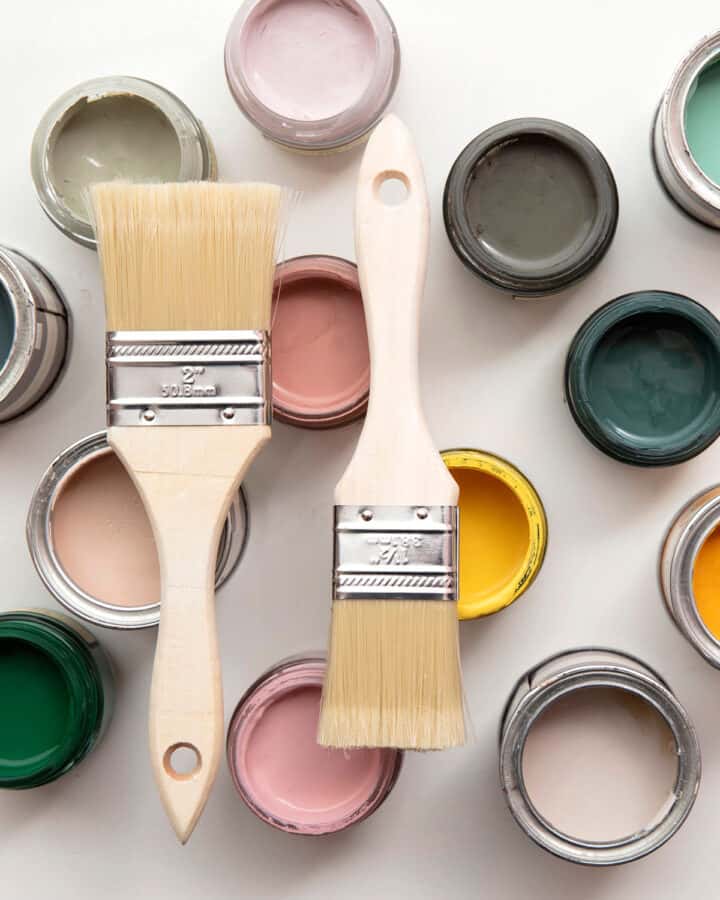
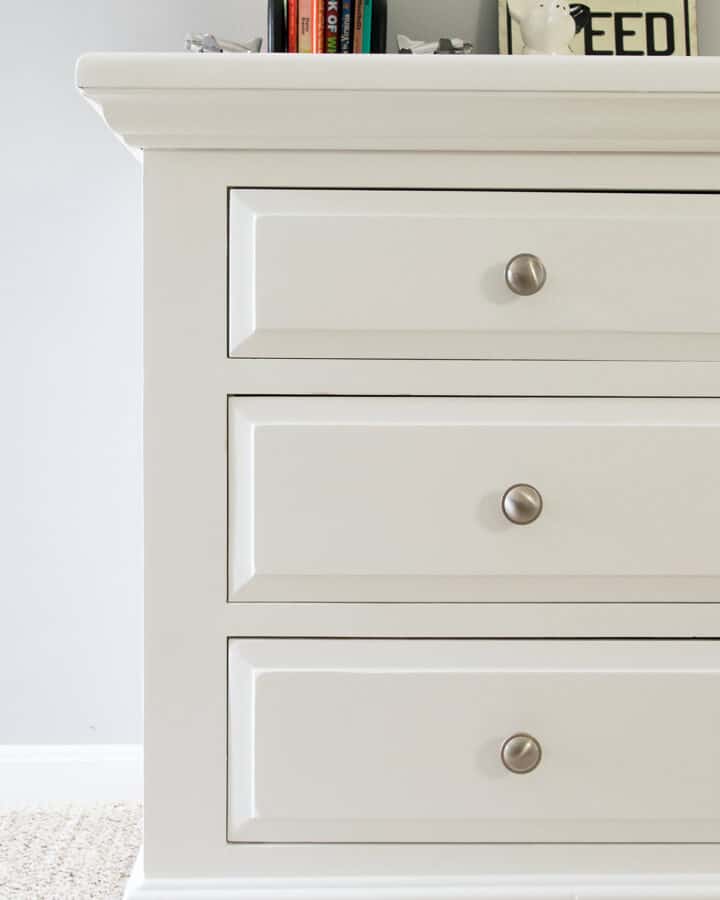
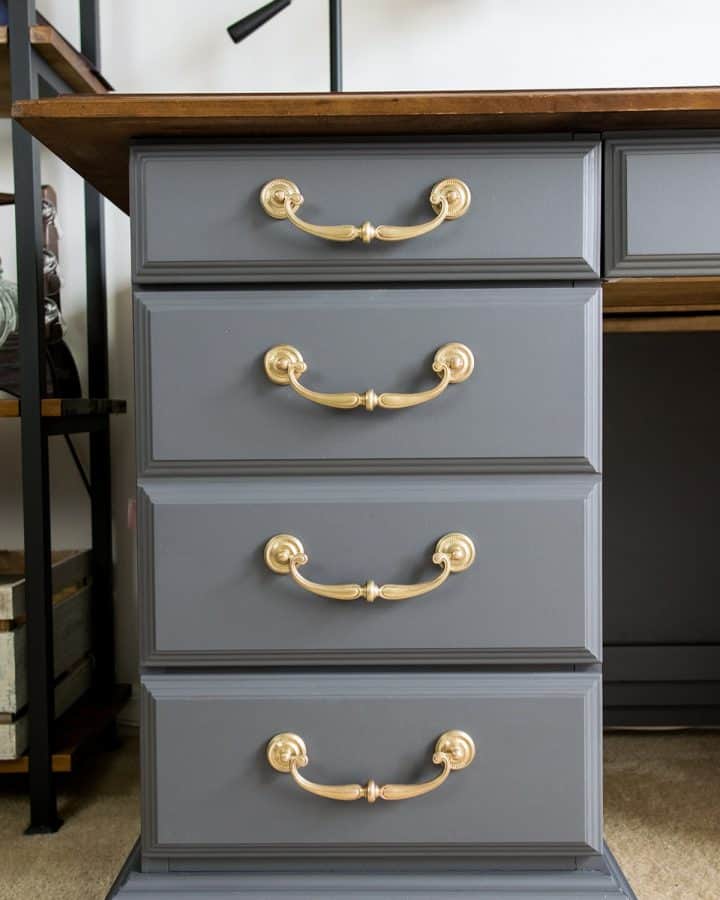
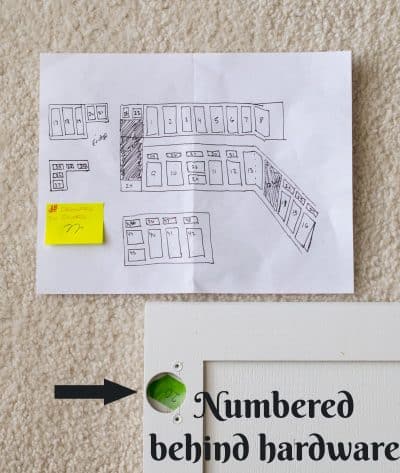
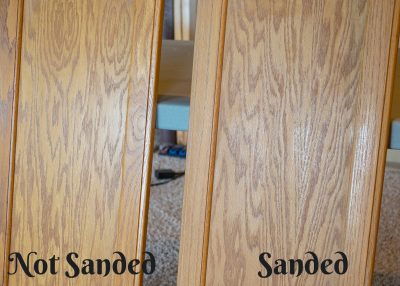
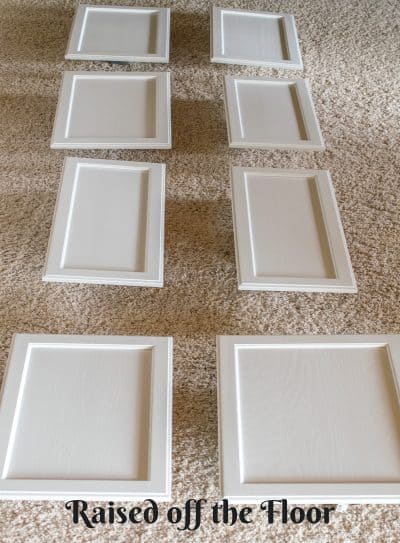
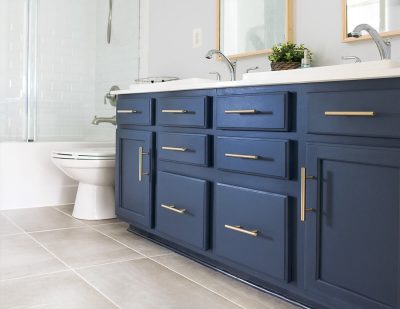
Priyanka says
Thanks for the insightful guide! Painting my bathroom vanity was a breeze with your tips. The easy steps you provided made the entire process enjoyable. Looking forward to more DIY projects on your blog!